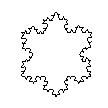

Fractals
A fractal is a self-similar object created beginning with a seed (also called an initiator) and repeatedly altering the seed according to a rule (called the generator). The rule can theoretically be applied an infinite number of times.
Fractal objects lend themselves to visual representation. Because the generating rule is intended to be applied infinitely, the modifications to the seed, although often simple to state, result in objects of staggering visual complexity. Before the advent of computer graphics, fractals were extremely difficult to study. Because fractals are so visually interesting and they are now easily created with computers, interest in them has greatly increased in recent years.
Fractals have applications ranging from environmental modeling and astronomy to cinematography and cartography. They are very important to the branch of mathematics and physics known as Chaos Theory.
The Sierpinski Gasket and the Koch Snowflake (pictured here) are two examples of fractal images.


Copyright © 1999-2000 SciMathMN